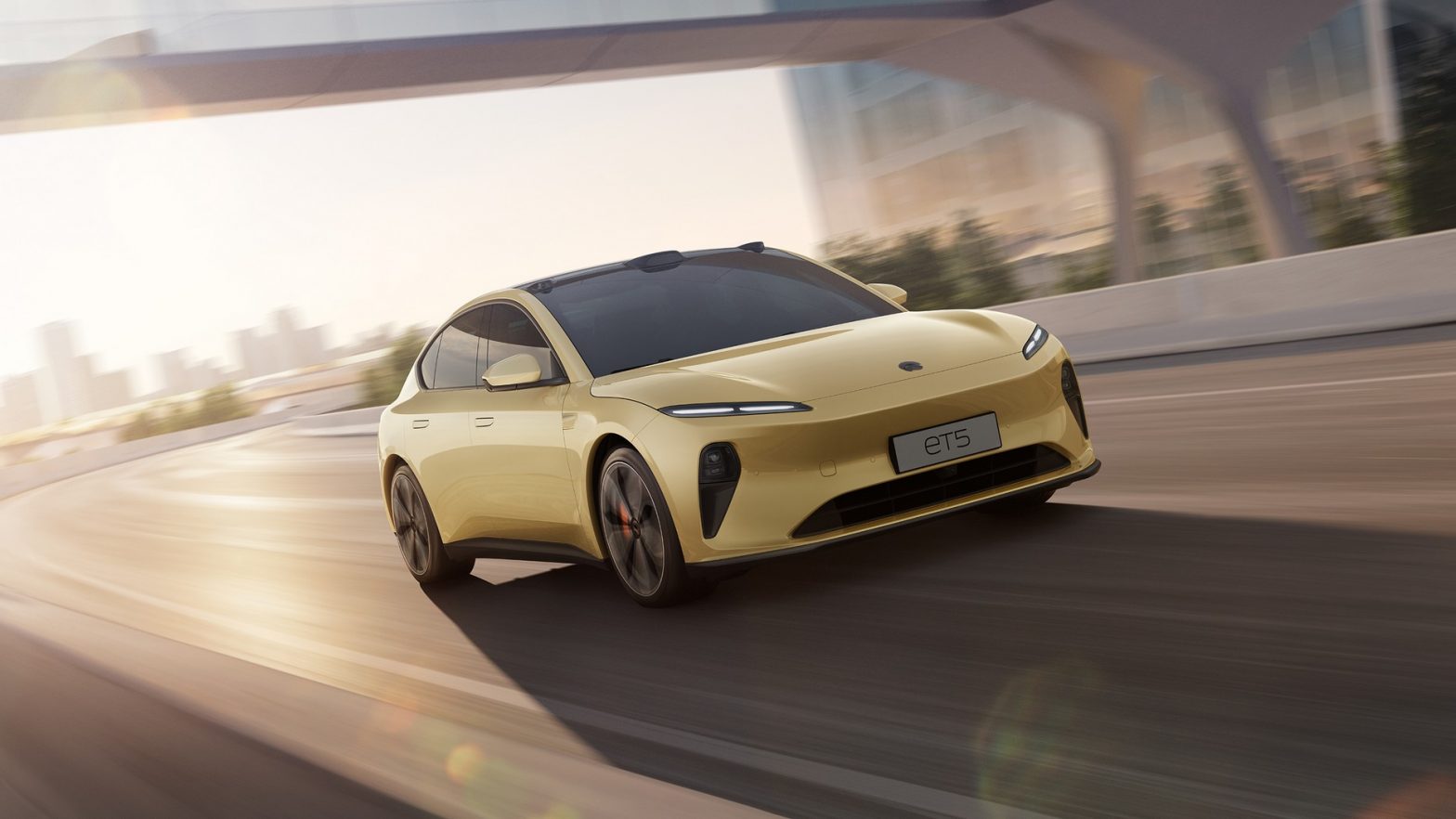The NIO ET5 is 4.79 m (188.6 inches) long, 1.96 m (77.2 in) wide, 1.50 m (59.1 in) tall, and has a 2.89 m (113.8 in) wheelbase. With a 1.28-square-meter (13.8 square feet) glass roof that blocks 99.9% of UV radiation, the EV will offer nine colors. NIO names its color options inspired by the sky, hence the Sunbathe Yellow and First Light Kiss options, exclusive to the ET5. NIO’s Airspace Blue is the company’s color for 2022. The NIO CEO presented the new sedan in Sunbathe Yellow and Airspace Blue.
The NIO ET5 has a 50:50 weight distribution, a gravity center at 482.6 mm (19 in), and an ultra-wide wheel track of 1,685 mm (66.4 in). That gives the new electric sedan a rollover-resistance rating of 1.7. Suggesting which country NIO wants to reach until 2025, the company mentioned that this rating is above NHTSA‘s five-star criteria. NIO said it would be in 25 countries in four years.
Although the ET5 looks like a mini ET7 – if you can call a 4.79-meter car mini – the ET5 has a higher drag coefficient: 0.24 instead of the 0.208 its bigger brother brags about. Despite that, it will travel further with the same battery packs. It is just a pity that NIO was not more specific.
The hybrid 75-kWh battery pack with LFP cells can make the ET7 have a 550-km (342-mi) range. The 100-kWh battery pack makes offers 705 km (438.1 mi) of range, and the future 150-kWh semi-solid-state battery pack will make it reach a 1,000-km (621.4-mi) range. NIO only said that the ET5 would exceed these results, and that was it.
The company is very proud of its battery swapping system and qualifies its battery packs as “chargeable, swappable, and upgradeable.” So far, it has already performed 5.5 million battery swaps – or around 20,000 swaps per day on average.
Thankfully, the longer ranges will not come at the expense of performance. The ET5 has a 150-kW (201-hp) induction motor at the front and a 210-kW (282 hp) permanent magnet motor at the rear. They deliver 700 Nm (516.3 pound-feet). NIO states that the electric sedan can go from 0 to 100 kph (97 mph) in 4.3 seconds.
The brakes with four-piston fixed calipers allow it to stop entirely from 100 kph in 33.9 meters (111.2 feet). The 50:50 weight distribution and the five-link suspensions taking care of all the car wheels certainly have helped. The ET5 has eight driving modes: Sport+, Sport, Comfort, Eco, Wet, Snow, Sand, Custom.
The “dinosaur stuff” is not the only thing Li praised about the ET5. He also seemed pretty proud of NIO Aquila Super Sensing and NIO Adam Super Computing, both connected to the ambition of eventually offering autonomous driving capacity.
Regarding NIO Aquila Super Sensing, it comprises 33 sensors: 11 high-resolution cameras, 1 ultralong-range high-resolution LiDAR, 5 millimeter-wave radar, 12 ultrasonic sensors, 1 ADMS, 2 high-precision location units (GPS plus IMU), and 1 V2X.
The NIO Adam Super Computing delivers 1,016 TOPS thanks to 4 NVIDIA Orin chips, 48 CPU cores, 256 sensor cores, 8,096 CUDA cores, and 68 billion transistors. It would be the most powerful processing in any production car, which may lead you to wonder when that will happen.
The NIO CEO was not as precise as he was about the ET7, but ET5’s bigger brother helped us have an idea. According to Li, the ET7 enters production lines on January 20, 2022, and deliveries will take place starting March 28, 2022. It means NIO starts producing its cars two months before deliveries. Considering ET5 deliveries will begin in September 2022, production must begin in July 2022.
The weird bit of the presentation comes down to the glasses NIO developed exclusively to the ET5 (until now). AR (augmented reality) glasses developed in a partnership with NREAL will allow NIO to avoid “that many displays in the car.” Volkswagen solved that with head-up displays in ID family cars. Let’s hope the AR glasses are not distracting. When the ET5 is parked, NIO wants owners to have fun with VR (virtual reality) glasses created with NOLO.
The Chinese carmaker includes both glasses as part of PanoCinema, an advanced entertainment system. Honestly, it is just a distraction when you check the technical specs.





